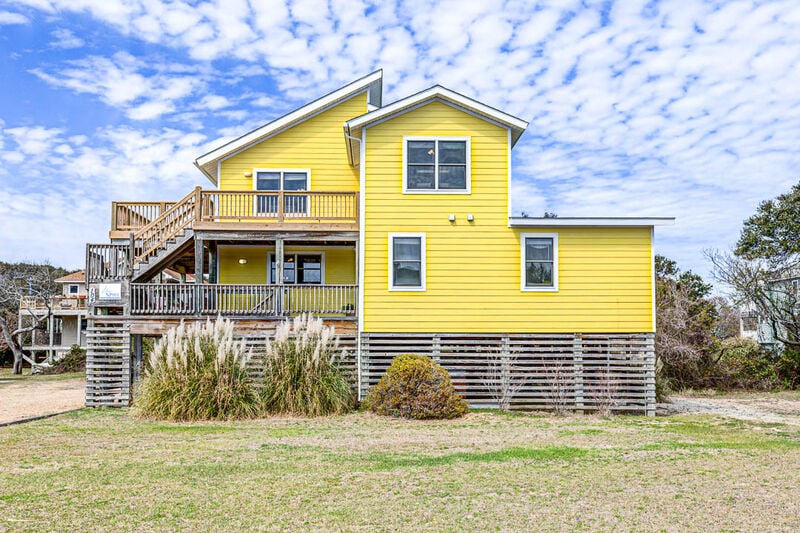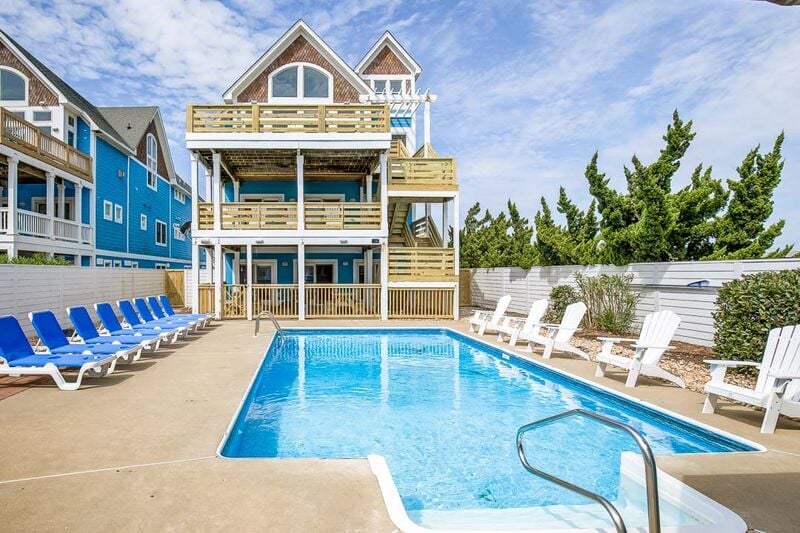 There are some very good reasons why the Outer Banks is considered the premier destination for surfers on the East Coast. Rather than list everything, we'll just reduce it to this—with 175 miles of beach and sandbar jutting out into the Atlantic Ocean there is almost always something to surf. That is not hyperbole; there is some very good science to back that up.
There are some very good reasons why the Outer Banks is considered the premier destination for surfers on the East Coast. Rather than list everything, we'll just reduce it to this—with 175 miles of beach and sandbar jutting out into the Atlantic Ocean there is almost always something to surf. That is not hyperbole; there is some very good science to back that up.Surfing on the Outer Banks
The shape of the Outer Banks is very much a part of why somewhere there are going to be waves. From Carova to Buxton, the Outer Banks face almost due east. At Buxton, which is where Cape Hatteras is located, there is a sharp bend to the southeast. That configuration means there is almost always a wind condition helping to create something to ride and, depending on where the swell is generated, there is going to be some place on the Outer Banks where the right conditions exist. This is also where ocean currents collide—the Labrador Current runs into the Gulf Stream must north of Cape Hatteras, although that varies a bit by season. It does add energy to the waves. There are a couple of other factors as well...but mostly it's the sand. The sandy bottom of the Outer Banks surf zone is constantly creating new sandbars, which is where the best break is always found. Generally, the fetch of the offshore current is north to south, although that changes depending on wind conditions and swell direction. As a consequence, there is usually a sandbar that has formed somewhere between Carova and Hatteras Village. It may take a bit of searching and perhaps an hour or hour and a half drive to the hot spot, but it is a rare day indeed when there is no break and no waves to ride.
Summer Surfing
Back at the beginning of our blog we mentioned there is almost always something to surf on the Outer Banks. Summer is the "almost" in the equation. There are times during the summer that the ocean looks more like Lake Atlantic than the wave machine that it usually is. There is a very well written and very informative article explaining what's happening in the summer on OBXSURFINFO.com by Dr. Jeff Hanson, an expert on how waves form. Dr. Hanson worked at the Field Research Facility (FRF) at Duck—the Duck Pier predicting wave patterns and formations before retiring six or seven years ago. What he explains is that the Outer Banks' summer weather is dominated by a Bermuda high, which is why we have great weather in the summer. But that weather pattern also creates lighter winds and smaller waves. There are exceptions to the smaller summertime waves. The Atlantic tropical storm season runs from June through November. Although tropical systems are not common from June through mid-August in the Atlantic, they do occasionally occur, almost always pushed out to sea by a combination of North American fronts and the Bermuda high. They do, though, generate very good surf conditions.
Fall Surfing
In many ways, fall is the best time for surfing on the Outer Banks. The peak heat of the summer is gone, but the water temperature stays in the 70s through Columbus Day and that pesky Bermuda high that has been suppressing waves has retreated. Weather systems paralleling the coast will sometimes create outstanding conditions, although that is not a common occurrence. When it does happen, though, 5'-7' waves with a long even break will be a part of the Outer Banks scene for three to four days. The shape of the Outer Banks comes into play at this point, with the southeast facing area from Buxton to Hatteras Village catching the first of the storm's wake, with the excellent conditions moving up the coast. This is also a time of the year when reading what day to day conditions are creating becomes an important part of the Outer Banks experience. Wave energy has increased and as it does so, sand is constantly being transported to different locations creating new temporary breaks. Wind conditions also play a role in the daily surf report. Generally speaking—although not always—west winds are helpful and east winds create chop and sloppier conditions. After Columbus day a wetsuit will probably be needed.
Winter Surfing
Get your wetsuit out, your crazy on, and be ready for a wild ride. The nor'easters that march up the East Coast in the winter generate the largest waves the Outer Banks experiences all year. There are typically two to three good nor'easters during the winter and it's reasonable to expect waves in the 8'-10' range. However, a March storm this past season (2018) generated waves 12'-15' in the surf zone. It should be apparent but let's be clear—these conditions are for experienced surfers only. Some important information to have: the water is going to be cold—37-40 degrees north of Cape Hatteras; a little bit warmer south. Those northeast winds create some really sloppy conditions, but find the right sandbar and there will be a good break. Try to find a sandbar a little closer to shore. There may be a great break 100 yards offshore, but with high surf and sloppy conditions, getting there is going to be a challenge, and getting back to the beach isn't going to be easy either. Even though nor'easters create the most dynamic environment, even when the sun is out and conditions moderate, there are still some great waves to catch. It may take some research and asking a few questions but there will be something out there.
Spring Surfing
It's rare for spring to have the spectacular waves of a winter nor'easter, but overall, it is the most consistent season of the year for good conditions. There are a number of reasons for that, most of it having to do with changing climate conditions, the flow of the Labrador Current and Gulf Stream and their interaction. This is a good time to find those shifting sandbars and surf a chest-high break. Spring seems to spawn at least one if not two nor'easters. Conditions are generally not quite as dire as the winter nor'easters, but there are some great waves to ride. North of Oregon Inlet the water stays in the 50s until June. Even south to Cape Hatteras water temps are chilly. A wet suit will be needed.









